Visitor responses
The idea was not to evaluate the Migration Memories exhibitions but to find out what they led people to think and feel. The documentation of open-ended conversations between visitors and researchers was the main form of collecting visitors’ responses.
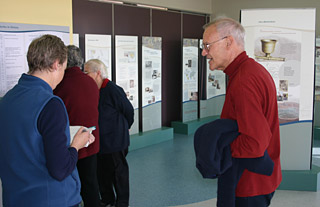 Mary taking notes at the Robinvale exhibition. Photograph: Laura Hartley |
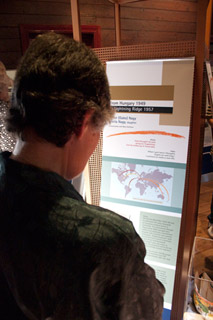 A Lightning Ridge exhibition visitor. Photograph: Ursula Frederick |
Collecting conversations
At Lightning Ridge, the verandah of the Historical Society Gallery provided an easy and natural space for talking to people. At Robinvale the openness of the space allowed room for small groups to converse and the outdoor play area provided further room. At the National Museum conversations were held in one of the Museum’s café spaces.
In documenting conversations with visitors, Mary worked with Ursula Frederick in Lightning Ridge, Laura Hartley in Robinvale, and Ange Casey in Canberra. One of the things they noticed was that the familiar, domestic quality of the local venues seemed to put people at ease. What Ursula called the ‘breathing space’ between the exhibition and everyday business encouraged conversation. It also gave young visitors room to move physically in and out of the exhibition. At the local venues visitors also often made return visits; to see more, to talk more, to bring someone else along.
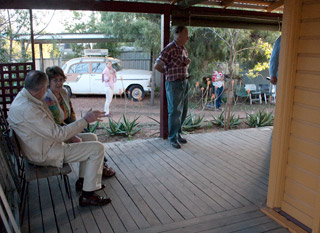 |
| The verandah of the Lightning Ridge Historical Society gallery. Photograph: Ursula Frederick |
Responses to the three exhibitions
A different mix of visitors came to each exhibition. At Lightning Ridge a significant proportion of visitors were tourists. At Robinvale the great majority of visitors were local residents. In Canberra at the National Museum most visitors had come to see the Museum itself and were not familiar with either of the localities.
A striking theme in local residents’ responses in both Lightning Ridge and Robinvale concerned learning more about their community through the exhibition. The conversations in Canberra generally reflected a stronger connection with the stories than the places.
Robinvale 23/6/07 (conversation 8) I know there are all these different nationalities here in Robinvale. You live in the middle of it, but you don’t really know. You don’t think about what it has taken to get here. |
 Visitors to the Robinvale exhibtion. Photograph: Mary Hutchison |
|
|
Lightning Ridge 4/9/06 (interview 1) ... and learning so much more – what one never knew about the individuals or families... It’s like you have walked into a huge living room and there are all these people who have all known each other but [the exhibition] actually connected some of them more to each other. |
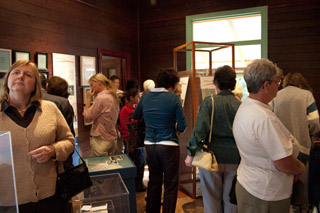 Lightning Ridge opening. Photograph: Ursula Frederick |
|
NMA conversation 20/11/07 I felt ‘in the people’ but not ‘in the place’… The thought provoking thing is that you realise how every Australian has a migration story and [that they often have] things that have been kept and treasured – things from ‘home’ that have been passed down. |
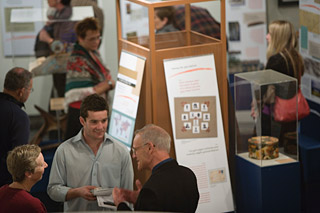 Visitors at the NMA exhibtion. Photograph: Lannon Harley |
Researcher's reflections on the conversations at each venue
Collecting conversations was an experiment in ways of gathering visitor responses. Researchers involved with the exhibitions commented on the conversations themselves and on what they revealed about exhibiting Australian migration history as something relevant to all Australians.
Ursula Frederick
Through their comments people were constantly making personal connections. The exhibition made them really think about their own family’s place in Australia; how they came to be there and where they were from. They were more interested in talking about this than answering questions about the exhibition itself.
Laura Hartley
That question about what people ‘make’ of things – how to catch that in a way that isn’t too co-constructive. You need a light question. And then there’s how something about the exhibition might surface later or become a reference point – how can you capture this?
Ange Casey
It was interesting to talk to visitors some time after they had seen the exhibition because the process of memory distillation was already well and truly on its way… The collecting process was a dialogue and inevitably became a meandering multilayered response to the exhibition that was ultimately about the resonance an exhibition can create.
Mary Hutchison
Talking with people reinforced how much both immediate frame of mind and established viewpoints can impact on the way people ‘see’ exhibitions. But people were also very open to information that gave them new insights. Some were very moved by the stories and keen to talk about what had touched them. I’d like to find a material way of collecting visitor responses – what object would you bring to put in this exhibition?
New conversations
One of the most interesting outcomes of the exhibitions was that they created conversations between people that might not otherwise have happened. A highlight of the project came with the opening of both exhibitions in Canberra which brought participants from each locality together.
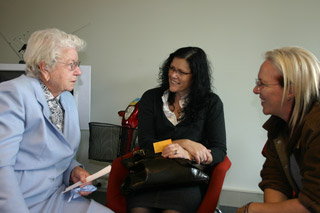 |
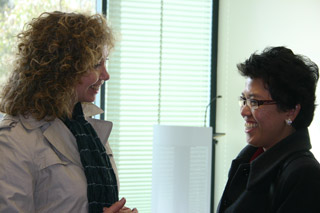 |
|
| Converations at the lunch for participants after the National Museum Australia launch of Migration Memories. Australian National University, September 2007. Photographs: Pip Deveson. |
||
